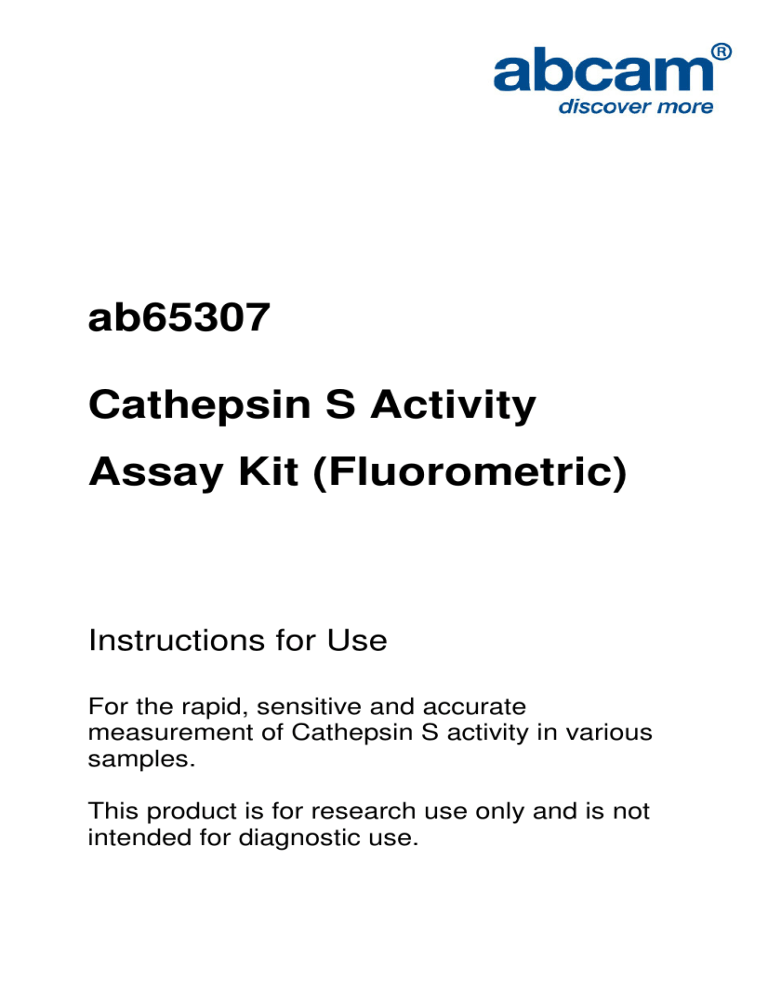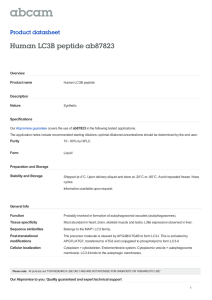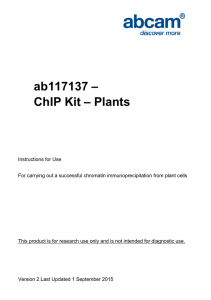ab65307 Cathepsin S Activity Assay Kit (Fluorometric)
advertisement

ab65307 Cathepsin S Activity Assay Kit (Fluorometric) Instructions for Use For the rapid, sensitive and accurate measurement of Cathepsin S activity in various samples. This product is for research use only and is not intended for diagnostic use. 1 Table of Contents 1. Overview 3 2. Protocol Summary 4 3. Components and Storage 5 4. Assay Protocol 6 5. Troubleshooting 8 2 1. Overview Apoptosis can be mediated by mechanisms other than the traditional caspase-mediated cleavage cascade. There is growing recognition that alternative proteolytic enzymes such as the lysosomal cathepsin proteases may initiate or propagate proapoptotic signals. Cathepsins are lysosomal enzymes that are also used as sensitive markers in various toxicological investigations. Abcam’s Cathepsin S Activity Assay Kit is a fluorescence-based assay that utilizes the preferred cathepsin-S substrate sequence VVR labeled with AFC (amino-4-trifluoromethyl coumarin). Cell lysates or other samples that contain cathepsin-S will cleave the synthetic substrate VVR-AFC to release free AFC. The released AFC can easily be quantified using a fluorometer or fluorescence plate reader. 3 2. Protocol Summary Lyse Cells Add CS Reaction Buffer A Add CS Substrate Measure Fluorescence 4 3. Components and Storage A. Kit Components Item Quantity CS Cell Lysis Buffer 25 mL CS Reaction Buffer 5 mL CS Substrate Ac-VVR-AFC (10 mM) CS Inhibitor (1mM) 200 µL 20 µL * Store kit at -20°C (Store CS Cell Lysis Buffer and CS Reaction Buffer at 4°C after opening). Protect CS Substrate from light. All reagents are stable for 6 months under proper storage conditions. B. Additional Materials Required • Microcentrifuge • Pipettes and pipette tips • Fluorometer or fluorescent microplate reader • 96 well plate • Orbital shaker 5 4. Assay Protocol 6 1. Collect cells (1-5 x 10 ) by centrifugation. Note: Use 50-200 µg cell lysates (in 50 µL of Cell lysis Buffer) if protein concentration has been measured. 2. Lyse cells in 50 µL of chilled CS Cell Lysis Buffer. Incubate cells on ice for 10 min. 3. Centrifuge at top speed in a microcentrifuge for 5 min, transfer the supernatant to a new tube. Add 50 µL of cell lysate to a 96well plate. 4. Add 50 µL of CS Reaction Buffer to each sample. 5. Add 2 µL of the 10 mM CS Substrate Ac-VVR-AFC (200 µM final concentration). Note: For negative control, add 2 µL of CS Inhibitor prior to adding CS Substrate, or make a reaction mixture that does not contain sample as control. 6. Incubate at 37°C for 1-2 hours. 6 7. Read samples in a fluorometer equipped with a 400-nm excitation filter and 505nm emission filter. You may also perform the entire assay directly in a 96-well plate. 8. Fold-increase in Cathepsin S activity can be determined by comparing the relative fluorescence units (RFU) with the level of the uninduced control or the negative control sample. If desired, the units of cathepsin S can be determined by generating a standard curve using free AFC under your assay conditions. 7 5. Troubleshooting Problem Assay not working High Background Reason Solution Cells did not lyse completely Re-suspend the cell pellet in the lysis buffer and incubate as described in the datasheet Experiment was not performed at optimal time after apoptosis induction Perform a time-course induction experiment for apoptosis Plate read at incorrect wavelength Ensure you are using appropriate reader and filter settings (refer to datasheet) Old DTT used Always use freshly thawed DTT in the cell lysis buffer Increased amount of cell lysate used Refer to datasheet and use the suggested cell number to prepare lysates Increased amounts of components added due to incorrect pipetting Incubation of cell samples for extended periods Use of expired kit or improperly stored reagents Contaminated cells Use calibrated pipettes Refer to datasheet and incubate for exact times Always check the expiry date and store the individual components appropriately Check for bacteria/ yeast/ mycoplasma contamination 8 Problem Lower signal levels Reason Cells did not initiate apoptosis Very few cells used for analysis Use of samples stored for a long time Incorrect setting of the equipment used to read samples Allowing the reagents to sit for extended times on ice Unanticipated results Measured at incorrect wavelength Cell samples contain interfering substances Solution Determine the time-point for initiation of apoptosis after induction (time-course experiment) Refer to datasheet for appropriate cell number Use fresh samples or aliquot and store and use within one month for the assay Refer to datasheet and use the recommended filter setting Always thaw and prepare fresh reaction mix before use Check the equipment and the filter setting Troubleshoot if it interferes with the kit (run proper controls) 9 Samples with erratic readings Uneven number of cells seeded in the wells Samples prepared in a different buffer Adherent cells dislodged and lost at the time of experiment Cell/ tissue samples were not completely homogenized Samples used after multiple freeze-thaw cycles Presence of interfering substance in the sample Use of old or inappropriately stored samples Seed only equal number of healthy cells (correct passage number) Use the cell lysis buffer provided in the kit Perform experiment gently and in duplicates/triplicates; apoptotic cells may become floaters Use Dounce homogenizer (increase the number of strokes); observe efficiency of lysis under microscope Aliquot and freeze samples, if needed to use multiple times Troubleshoot as needed Use fresh samples or store at correct temperatures until use For further technical questions please do not hesitate to contact us by email (technical@abcam.com) or phone (select “contact us” on www.abcam.com for the phone number for your region). 10 UK, EU and ROW Email: technical@abcam.com Tel: +44 (0)1223 696000 www.abcam.com US, Canada and Latin America Email: us.technical@abcam.com Tel: 888-77-ABCAM (22226) www.abcam.com China and Asia Pacific Email: hk.technical@abcam.com Tel: 108008523689 (中國聯通) www.abcam.cn Japan Email: technical@abcam.co.jp Tel: +81-(0)3-6231-0940 www.abcam.co.jp 11 Copyright © 2012 Abcam, All Rights Reserved. The Abcam logo is a registered trademark. All information / detail is correct at time of going to print.

![Anti-DR4 antibody [B-N28] ab59481 Product datasheet Overview Product name](http://s2.studylib.net/store/data/012243732_1-814f8e7937583497bf6c17c5045207f8-300x300.png)


